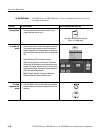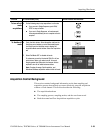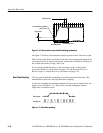
Acquiring Waveforms
CSA7000 Series, TDS7000 Series, & TDS6000 Series Instruments User Manual
3-43
The instrument uses equivalent time sampling to extend its sample rate beyond
its real-time maximum sampling rate, but only under two conditions:
H You must have selected equivalent-time in the Acquisition Setup control
window.
H You must have set the instrument to a sampling rate that is too fast to allow
it to get enough samples with which to create a waveform record using
real-time sampling.
If both conditions are met, the instrument takes a few samples with each trigger
event and eventually obtains enough samples to construct a waveform record.
The instrument makes multiple acquisitions of a repetitive waveform to obtain
the sample density required for a waveform record. (See Figure 3--12.) Equiva-
lent-time sampling should only be used on repetitive signals.
The sampling speeds and the number of channels that you choose affect the
mode the instrument uses to sample waveforms:
H The instrument always real-time samples at slower time base settings; faster
time settings force the instrument to switch from real-time sampling to
equivalent-time sampling or interpolation, depending on whether Equivalent
Time or Interpolated Real T ime is selected.
H The instrument extends the limit at which it must switch from real-time
sampling by using the digitizers of channels that are turned off to sample the
channel or channels that are turned on.
Check Table 3--2 below to determine the time base setting(s) at which the switch
from real-time sampling (RT) to equivalent time sampling or interpolation (ETI)
occurs for your instrument.
Equivalent-Time Sampling


















